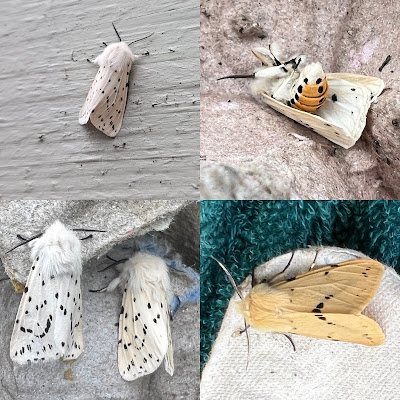We have been in Greece on holiday and there was plenty to enjoy in the sun - the sea and beach, ancient ruins and of course butterflies and moths. But I left my packing until too late in the day to finish this little tidy-up of moths and other wildlife which caught my eye, and other's, in the week before we went away.
The collection of ermine moths above was one of the modest highlights, especially the one which was so comatose that it rolled over on its back, went back to sleep and allowed me to photograph its plump and stripey-spotty body. I was interested too in the slight variation in background colour between two of the White Ermines, bottom left above, which was rather stronger to the eye than it is in the photograph. The one on the right had an almost nicotine-stained appearance, coming closer to the caramel of the Buff Ermine in the bottom right picture. Both species are very prone to variation, with all manner of dots and sometimes even black streaks although the standard forms are much the most common.
As readers will have sussed, I have many young relations who show a great interest in wildlife and by chance my great-niece Frankie had an excellent spot of a White Ermine just a couple of days ago. Here is her photo, above - an interesting example with relatively few spots. I checked whether it might be the much rarer Water Ermine, but that is almost completely white.
The moth is one of the commonest which I get asked to identify, along with the Angle Shades. Indeed my older sister was on the case when Frankie posted her picture on our family's Insect Watch WhatsApp. As she said, it always reminds us of a fake ermine stole owned by our own Granny which became a key, if gradually rather tatty element of our dressing-up box. My younger sister joined in shortly afterwards with another great picture, above, showing two clearly varied White Ermines which came as an unexpected bonus on a shopping trip. In the wider world, it is encouraging how many people identify the moth correctly and just want to double-check.
 One of my grandsons, Luca, also sent this excellent photo, above, of a Cinnabar with its warning colouration which, as he and his Mum noticed, becomes even stronger when it flies off in a whirr of its bright red underwing 'skirts'. It is happily poisonous to birds, a danger also signalled by its caterpillars with the different bright colours of yellow and black, the same as our own
One of my grandsons, Luca, also sent this excellent photo, above, of a Cinnabar with its warning colouration which, as he and his Mum noticed, becomes even stronger when it flies off in a whirr of its bright red underwing 'skirts'. It is happily poisonous to birds, a danger also signalled by its caterpillars with the different bright colours of yellow and black, the same as our own My favourite newspaper the Daily Star meanwhile did its bit to encourage interest in entomology, albeit in the somewhat over-dramatised presentation of a caterpillar plague. The Large White nibblers illustrated will be familiar to anyone who takes on the thankless task of growing cabbages in England.
This time of the year is very good for inspecting plants in your garden whose leaves are being eaten, to see if anything interesting is responsible. I found this little chap, below, which Dave Wilton on the invaluable Upper Thames Moths blog suggests may be the pleasantly-named micro, the Timothy Tortrix. Timothy grass is among its favourite foodplants, although it also goes by the grander name of Zelotherses paleana.
My sister with the bonus White Ermines is hosting a large family of Mullein moth caterpillars on her Verbascums which are also under siege by shield bugs. She has been investigating the Mullein and reported on Insect Watch about its toxic properties, similar to the Cinnabar, and the curious fact that after a short life of some 30 days, the caterpillars pupate underground and may not emerge as adult insects for several years. Then they mate, the female lays eggs, both partners die and the circle starts again.
Insect Watch readers are always interested in scientific observation, some of them especially so when it concerns animals going to the loo...
I meanwhile had a narrow escape when clearing out a shed. I almost rested my hand on this hornet below. I like hornets which are boldly-coloured creatures and not at all aggressive. But anything subjected to the full weight of me would certainly try to defend itself and they have a nasty sting.
Before we jetted off to Greece, the moth trap brought me some pleasant visitors, most of which are shown below. I'll come back shortly to update with full IDs but the bottom two in the quartet below are a Willow Beauty and a Figure of Eighty (look at the squiggly pattern on its side).
And below we have a Poplar Hawk - my only hawk moth so far in this rather chilly Summer - two varied Treble Lines and in the bottom right hand corner a Buff Footman.













No comments:
Post a Comment